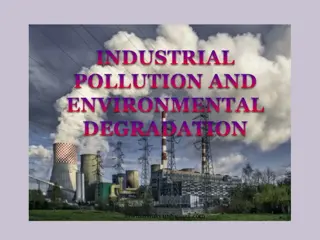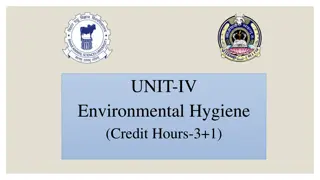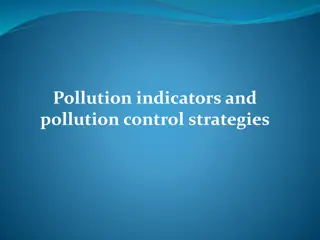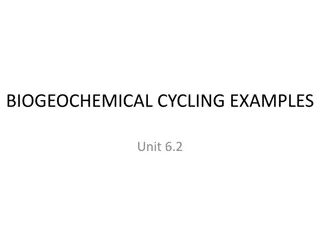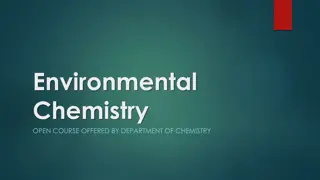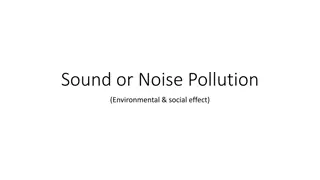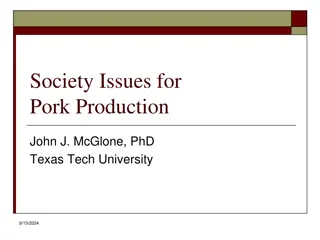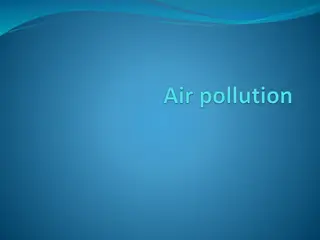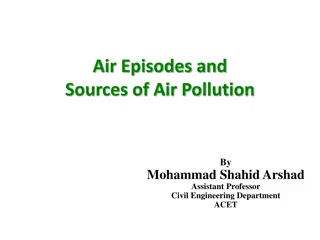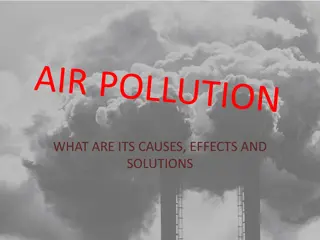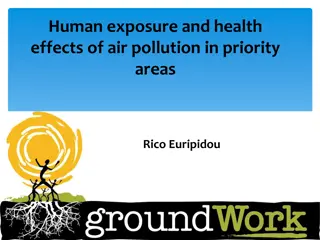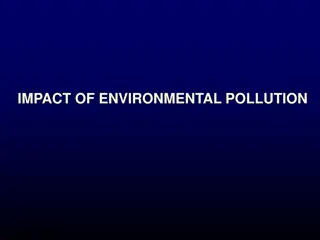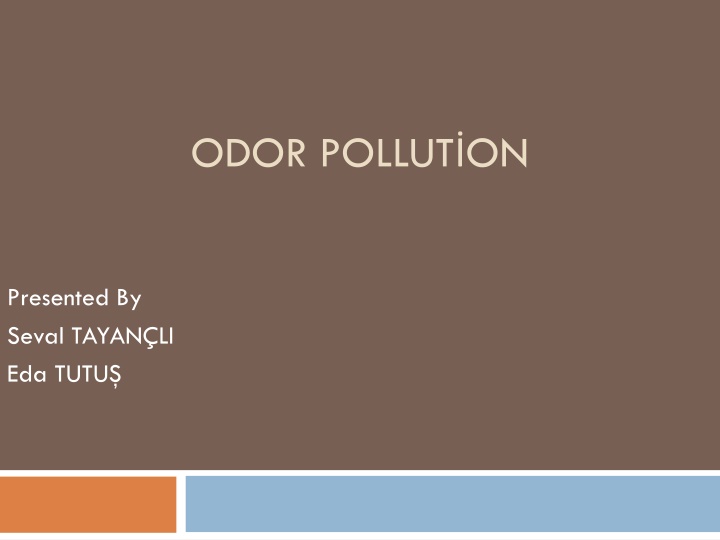
Odor Pollution: Environmental Concerns and Solutions
Odor pollution is a significant environmental issue affecting public health and quality of life. Industrial activities contribute to odorous compounds in the environment, necessitating efforts to mitigate odor levels. Understanding the sources of odors, such as chemical industries, pharmaceutical facilities, and animal feedlots, is crucial for effective abatement strategies. Major odor compounds like ammonia, hydrogen sulfide, and phenol impact human senses with distinct odors, signaling the need for comprehensive odor management practices.
Download Presentation

Please find below an Image/Link to download the presentation.
The content on the website is provided AS IS for your information and personal use only. It may not be sold, licensed, or shared on other websites without obtaining consent from the author. If you encounter any issues during the download, it is possible that the publisher has removed the file from their server.
You are allowed to download the files provided on this website for personal or commercial use, subject to the condition that they are used lawfully. All files are the property of their respective owners.
The content on the website is provided AS IS for your information and personal use only. It may not be sold, licensed, or shared on other websites without obtaining consent from the author.
E N D
Presentation Transcript
ODOR POLLUTON Presented By Seval TAYAN LI Eda TUTU
Odor is an important environmental pollution issue because it can affect public amenity and the community s quality of life. Attention to odor as an environmental nuisance has been growing as a result of increasing industrialization and the awareness of people s need for a clean environment.
Efforts to abate odor levels are necessary in order to maintain the quality of the environment. Understanding the odor problem and the origin and dispersion of odors, abatement and detection methods are, therefore, very important aspects of odor pollution in the environment.
Sources of odor in the environment Source Odorous Compounds Reference 1)Chemical and petroleum industries: a)Refineries: Hydrogen sulfide, sulfur dioxide, ammonia, organic acids, hydrocarbons, mercaptans, aldehydes Cheremisinoff (1992) b) Inorganic chemicals Ammonia, aldehydes, hydrogen sulfide, sulfur dioxide Cheremisinoff (1992) c) Organic chemicals Ammonia, aldehydes, sulfur dioxide, mercaptans, organic acid Cheremisinoff (1992) 2) Pharmaceutical industry Aldehydes, aromatic, phenol, ammonia, etc. Cheremisinoff (1992) 3) Rubber, plastics, glass industries Nitro compounds,sulfur oxides, solvents, aldehydes, ketones, phenol, alcohols Cheremisinoff (1992)
Sources of odor in the environment Source Odorous Compounds Reference 4) Composting facilities Ammonia, sulfur containing compounds, terpene, alcohols,aldehydes,ester, ketones, volatile fatty acids (VFA) Gudladt (2001) 5) Animal feedlots Ammonia, hydrogen sulfides, alcohol, aldehydes, N2O Janni et al. (2000) 6) Wastewater treatment plant Hydrogen sulfides, mercaptan, ammonia, amines, skatoles, indoles, etc. Huber (2002); Nurul Islam et al. (1998)
Major Odor Compounds and Their Senses Compound Formula Odor Sense Acetaldehyde CH3CHO Pungent Ammonia NH3 Pungent Butyric acid CH3CH2CH2COOH Rancid Diethyl sulfide C2H5C2H5S Garlic Dimethyl amine CH3CH3NH Fishy Dimethyl sulfide CH3CH3S Decayed cabbage Ethyl mercaptan C2H5SH Decayed cabbage Formaldehyde HCHO Pungent Hydrogen sulfide H2S Rotten eggs Methyl mercaptan CH3SH Decayed cabbage Phenol C6H5OH Empyreumatic Propyl mercaptan C3H7SH Unpleasent Sulfur dioxide SO2 Pungent Trimethyl amine CH3CH3CH3N Fishy Valeric acid CH3CH2CH2CH2COOH Body odor
Understanding Odor Characteristics The following are examples of the relationship between the odor characteristics and their significance for pollution control [Card, 1998]: 1. Vapor pressure 2. Solubility in water 3. Ionization
Odor Pollution Reduction Technologies There is no single treatment technology that can effectively and economically be applied to every industrial or commercial application. The effectiveness of a technology can often be defined by the flow rates and concentrations at which adequate cost-effective treatment can be expected.
adsorption using activated carbon, zeolite, alumina (disposable or with regeneration); dry chemical scrubbing - solid phase impregnated with chemical agents such as pH modifiers, chlorine dioxide or permanganate; biological treatment trickling biofilters, soil bed biofilters, non-soil biofilters (peat, heather, wood bark, compost), bioscrubbers; absorption (scrubbing) - spray and packed towers, plate absorbers (single pass or recirculating); thermal treatment - existing boiler plant, thermal or catalytic oxidation; other techniques odour treatment chemicals, condensation, plasma technology (ozone), catalytic iron filters and UV.
Biological Systems Biological treatment is effective and economical for low concentrations of contaminants in large quantities of air. Biological systems for odor control rely basically on the microorganism activity that converts odor compounds in the waste air or wastewater to carbon dioxide and water as in a chemical system. Biological systems include biofilters, biological scrubbers (or bioscrubbers), and biological trickling filters (or biotrickling filters).
1.BIOFILTERS Advantages Simple operation Low investment costs Low running costs Degradation of less watersoluble pollutant Suitable for reduction of odorous pollutants Disadvantages Low waste-air volumetric flow rate Only low pollutant concentration Process control impossible Channeling of air flow is normal Limited service life of filter bed Excess biomass not disposable
2.BIOTRICKLING FILTERS Advantages Simple operation Low investments costs Low running costs Suitable for moderately contaminated waste air Ability to control pH Ability to add nutrients Disadvantages Limited process control Channeling can be a problem Limit service life of filter bed Excess biomass not disposable
3.BIOSCRUBBERS Advantages Good process control possible High mass transfer Suitable for highly contaminated waste air Suitable for process modeling High operational stability Ability to add nutrients Disadvantages High investment cost High running cost Production of excess biomass Disposal of water Possible plugging in adsorption stage
ODOR POLLUTION DETECTION INSTRUMENTATION 1.Chemical Sensors A chemical sensor is a device that responds to a particular analyte in a selective way through a chemical reaction, and which can be used for the qualitative or quantitative determination of the analyte. The working principles of a chemical sensor are primarily based on the interaction between sample input (e.g. odor molecules) and the chemically sensitive materials on the sensor surface.
Chemical sensor applications relevant to the odor and volatile organic compound (VOC) emissions detection Application fields Detection objects Sensors Reference 1. Environmental control -Propane, Propanol - Metal oxides sensor with multivariate analysis - Althainz et al. (1996) 2. Measurements in working areas - Gas mixture analysis - MOSFET sensor with PCA and artificial neural network - Ekl v and Lundstr m (1999) 3. Emission measurements - Waste water Separation - Polypirrole sensors with multivariate analysis - Bourgeois and Stuetz (2000) 4. Process control and regulation - Bioreactor off-gas Composition Monitoring - MOSFET sensor with PCA - Bachinger et al. (2000) 5. Medical applications - Urine analysis - QCM sensors with PCA - Di Natale et al. (1999) 6. Agricultural - Vinegar discrimination - AromaScan electronic nose - Anklam et al. (1998)
2.Olfactometry and Gas Chromatography Olfactometer is the state-of-the-art odor measurement system. It is used to measure the odor detection threshold and the hedonic tone of an odor substance. Odor compounds can also be recognized by means of analytical instruments such as gas chromatography.
3.Electronic Noses Gardner and Bartlett (1999) defined the E-nose as an instrument that comprises an array of electronic, chemical sensors with partial specificity and an appropriate pattern recognition system, capable of recognizing simple or complex odors. This definition restricts the term E-nose to those types of sensor array systems that are specifically used to sense odorous molecules in an analogous manner to the human nose.
Odor-related regulations in selected countries (USA, Germany, and Canada) (adapted from Hellwig (1998) and Bockreis (1999)) Country Regulations Remarks USA Clean Air Act (CAA) Regulates stationary sources of volatile organic compounds (VOC) Germany Occupational Safety and Health Act (OSHA) Provides the basis for regulations protecting workers in the workplace Canada The Environmental Protection and Enhancement Act (EAPA) in Alberta Province Prohibitions against the release of compounds that cause a significant adverse effect
The Federal Clean Air Act (the Act) does not specifically regulate odor, however, odors are typically addressed through State nuisance regulations or common law of affected States. Contact your state environmental agency to get more specific information. Regarding odor concerns, odors are difficult to investigate due to the variation in odor thresholds of different pollutants and the varying sensitivity of individuals to odors. In some cases, odor concerns can be an be pursued through the application of the secondary National Ambient Air Quality Standards (NAAQS), discussed further below, in relation to enjoyment of life, property, and the environment. http://www.epa.gov/region5/agriculture/faqs.html
REFERENCES http://dspace.library.cornell.edu/bitstream/1813/10399/1/ Invited%20overview%20Lammers%2012July2004.pdf http://www.enviroware.com/portfolio/odor-pollution/ http://www.env.go.jp/en/air/odor/measure/02_1_4.pdf http://www.epa.gov/region5/agriculture/faqs.html



